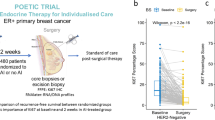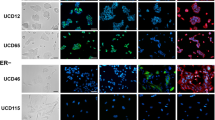Abstract
Introduction Changes in breast cancer cell biology following hormonal treatment have been claimed as promising predictor markers of clinical benefit even outperforming clinical response. From previous work we selected 10 genes showing both a well known regulation by oestrogen and a high level of early transcriptional regulation following therapy with aromatase inhibitors. Here we use an animal breast cancer model to explore the feasibility of the determination of their expression in minimally invasive samples and to further assess the magnitude of their regulation by letrozole. Animal and methods Aromatase inhibitor sensitive breast cancer tumours were grown in athymic mice under supplement with androstenedione. Following initial tumour growth animals were assigned to a control group or to receive letrozole at two different dosages. Fine needle aspirates were obtained at the moment of treatment assignation and one week later. Expression of the following genes at both time points was determined: Ki-67, Cyclin D1, pS2, Trefoil Factor 3, PDZ domain containing 1, Ubiquitin-conjugating enzyme E2C, Stanniocalcin 2, Topoisomerase 2 alfa, MAN1A1 and FAS. Results Fine needles aspirates were found to be a feasible and reproducible technique for RNA extraction. Trefoil Factor 3, pS2, Cyclin D1 and Stanniocalcin 2 were significantly downregulated by letrozole. Among them pS2 appears to be most sensitive to aromatase inhibitor treatment even differentiating sub-optimal from optimal letrozole dosage. Discussion We present pre-clinical evidence to justify the exploration in clinical trials of pS2, Trefoil factor 3, Cyclin D1 and Stanniocalcin as dynamic markers of oestrogen-driven pathway activation.


Similar content being viewed by others
References
Abe O et al (2005) Effects of chemotherapy and hormonal therapy for early breast cancer on recurrence and 15-year survival: an overview of the randomised trials. Lancet 365(9472):1687–1717
Smith IE, Dowsett M (2003) Aromatase inhibitors in breast cancer. N Engl J Med 348(24):2431–2442
Bajetta E, Celio L, Di Leo A et al (1998) Effects of short-term pre-operative tamoxifen on steroid receptor and Ki-67 expression in primary breast cancer: an immunocytochemical study. Int J Oncol 12(4):853–858
Bundred NJ, Anderson E, Nicholson RI et al (2002) Fulvestrant, an estrogen receptor downregulator, reduces cell turnover index more effectively than tamoxifen. Anticancer Res 22(4):2317–2319
Clarke RB, Laidlaw IJ, Jones LJ et al (1993) Effect of tamoxifen on Ki67 labelling index in human breast tumours and its relationship to oestrogen and progesterone receptor status. Br J Cancer 67(3):606–611
Dardes RD, Horiguchi J, Jordan VC (2000) A pilot study of the effects of short-term tamoxifen therapy on Ki-67 labelling index in women with primary breast cancer. Int J Oncol 16(1):25–30
Decensi A, Robertson C, Viale G et al (2003) A randomized trial of low-dose tamoxifen on breast cancer proliferation and blood estrogenic biomarkers. J Natl Cancer Inst 95(11):779–790
DeFriend DJ, Howell A, Nicholson RI et al (1994) Investigation of a new pure antiestrogen (ICI 182780) in women with primary breast cancer. Cancer Res 54(2):408–414
Dowsett M, Bundred NJ, Decensi A et al (2001) Effect of raloxifene on breast cancer cell Ki67 and apoptosis: a double-blind, placebo-controlled, randomized clinical trial in postmenopausal patients. Cancer Epidemiol Biomarkers Prev 10(9):961–966
Dowsett M, Dixon JM, Horgan K et al (2000) Antiproliferative effects of idoxifene in a placebo-controlled trial in primary human breast cancer. Clin Cancer Res 6(6):2260–2267
Dowsett M, Jones A, Johnston SR et al (1995) In vivo measurement of aromatase inhibition by letrozole (CGS 20267) in postmenopausal patients with breast cancer. Clin Cancer Res 1(12):1511–1515
Robertson JF, Nicholson RI, Bundred NJ et al (2001) Comparison of the short-term biological effects of 7alpha-[9-(4,4,5,5,5-pentafluoropentylsulfinyl)-nonyl]estra-1,3,5, (10)-triene-3,17beta-diol (Faslodex) versus tamoxifen in postmenopausal women with primary breast cancer. Cancer Res 61(18):6739–6746
Assersohn L, Salter J, Powles TJ et al (2003) Studies of the potential utility of Ki67 as a predictive molecular marker of clinical response in primary breast cancer. Breast Cancer Res Treat 82(2):113–123
Billgren AM, Rutqvist LE, Tani E et al (1999) Proliferating fraction during neoadjuvant chemotherapy of primary breast cancer in relation to objective local response and relapse-free survival. Acta Oncol 38(5):597–601
Ellis MJ, Coop A, Singh B et al (2003) Letrozole inhibits tumor proliferation more effectively than tamoxifen independent of HER1/2 expression status. Cancer Res 63(19):6523–6531
Frasor J, Danes JM, Komm B et al (2003) Profiling of estrogen up- and down-regulated gene expression in human breast cancer cells: insights into gene networks and pathways underlying estrogenic control of proliferation and cell phenotype. Endocrinology 144(10):4562–4574
Geisler J, Haynes B, Anker G et al (2002) Influence of letrozole and anastrozole on total body aromatization and plasma estrogen levels in postmenopausal breast cancer patients evaluated in a randomized, cross-over study. J Clin Oncol 20(3):751–757
Kenny FS, Willsher PC, Gee JM et al (2001) Change in expression of ER, bcl-2 and MIB1 on primary tamoxifen and relation to response in ER positive breast cancer. Breast Cancer Res Treat 65(2):135–144
Cunliffe HE, Ringner M, Bilke S et al (2003) The gene expression response of breast cancer to growth regulators: patterns and correlation with tumor expression profiles. Cancer Res 63(21):7158–7166
Mackay AG, Urruticoechea A, Dixon JM et al (2007) Molecular response to aromatase inhibitor treatment in primary breast cancer. Breast Cancer Res 9(3):R37
Lee K, Macaulay VM, Nicholls JE et al (1995) An in vivo model of intratumoural aromatase using aromatase-transfected MCF7 human breast cancer cells. Int J Cancer 62(3):297–302
Jelovac D, Macedo L, Goloubeva OG et al (2005) Additive antitumor effect of aromatase inhibitor letrozole and antiestrogen fulvestrant in a postmenopausal breast cancer model. Cancer Res 65(12):5439–5444
Normanno N, Di Maio M, De Maio E et al (2005) Mechanisms of endocrine resistance and novel therapeutic strategies in breast cancer. Endocr Relat Cancer 12(4):721–747
Dowsett M, Ebbs SR, Dixon JM et al (2005) Biomarker changes during neoadjuvant anastrozole, tamoxifen, or the combination: influence of hormonal status and HER-2 in breast cancer – a study from the IMPACT trialists. J Clin Oncol 23(11):2477–2492
Gil M, Perez X, Azpeitia D (2001) Toremifene as primary therapy for locally advanced and large-operable breast cancer. Phase II study. The Breast 10(suppl. 1):S35
Rubio-Viqueira B, Jimeno A, Cusatis G et al (2006) An in vivo platform for translational drug development in pancreatic cancer. Clin Cancer Res 12(15):4652–4661
Herber B, Truss M, Beato M et al (1994) Inducible regulatory elements in the human cyclin D1 promoter. Oncogene 9(4):1295–1304
Allan AL, Albanese C, Pestell RG et al (2001) Activating transcription factor 3 induces DNA synthesis and expression of cyclin D1 in hepatocytes. J Biol Chem 276(29):27272–27280
Jakowlew SB, Breathnach R, Jeltsch JM et al (1984) Sequence of the pS2 mRNA induced by estrogen in the human breast cancer cell line MCF-7. Nucleic Acids Res 12(6):2861–2878
Chambon P, Dierich A, Gaub MP et al (1984) Promoter elements of genes coding for proteins and modulation of transcription by estrogens and progesterone. Recent Prog Horm Res 40:1–42
Nunez AM, Jakowlev S, Briand JP et al (1987) Characterization of the estrogen-induced pS2 protein secreted by the human breast cancer cell line MCF-7. Endocrinology 121(5):1759–1765
Berry M, Nunez AM, Chambon P (1989) Estrogen-responsive element of the human pS2 gene is an imperfectly palindromic sequence. Proc Natl Acad Sci USA 86(4):1218–1222
May FE, Westley BR (1997) Expression of human intestinal trefoil factor in malignant cells and its regulation by oestrogen in breast cancer cells. J Pathol 182(4):404–413
Wagner GF, Hampong M, Park CM et al (1986) Purification, characterization, and bioassay of teleocalcin, a glycoprotein from salmon corpuscles of Stannius. Gen Comp Endocrinol 63(3):481–491
Charpentier AH, Bednarek AK, Daniel RL et al (2000) Effects of estrogen on global gene expression: identification of novel targets of estrogen action. Cancer Res 60(21):5977–5983
Bouras T, Southey MC, Chang AC et al (2002) Stanniocalcin 2 is an estrogen-responsive gene coexpressed with the estrogen receptor in human breast cancer. Cancer Res 62(5):1289–1295
Author information
Authors and Affiliations
Corresponding author
Additional information
Ander Urruticoechea and Helena Aguilar contributed equally to this work.
Rights and permissions
About this article
Cite this article
Urruticoechea, A., Aguilar, H., Solé, X. et al. Pre-clinical validation of early molecular markers of sensitivity to aromatase inhibitors in a mouse model of post-menopausal hormone-sensitive breast cancer. Breast Cancer Res Treat 109, 463–470 (2008). https://doi.org/10.1007/s10549-007-9676-7
Received:
Accepted:
Published:
Issue Date:
DOI: https://doi.org/10.1007/s10549-007-9676-7




